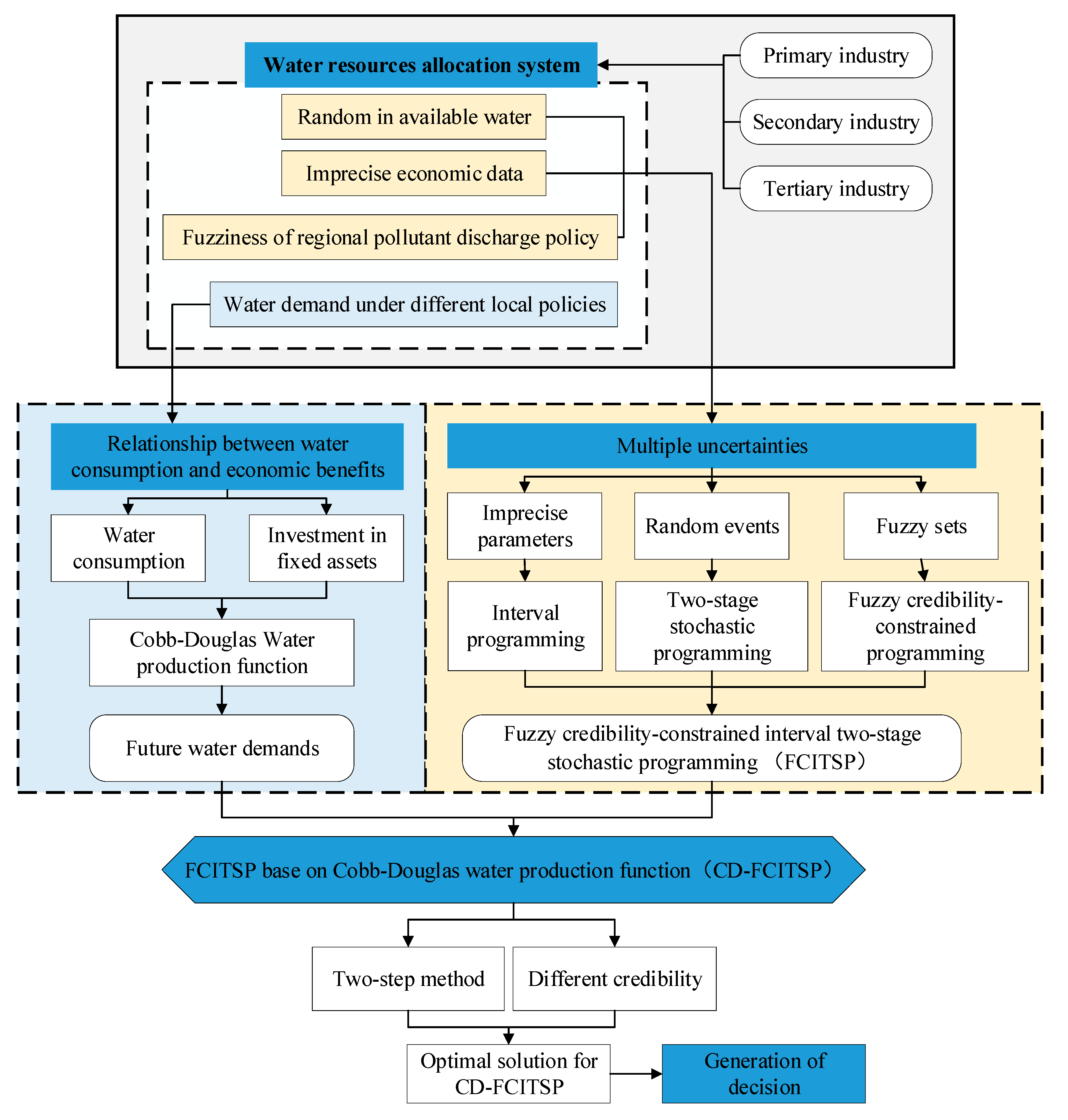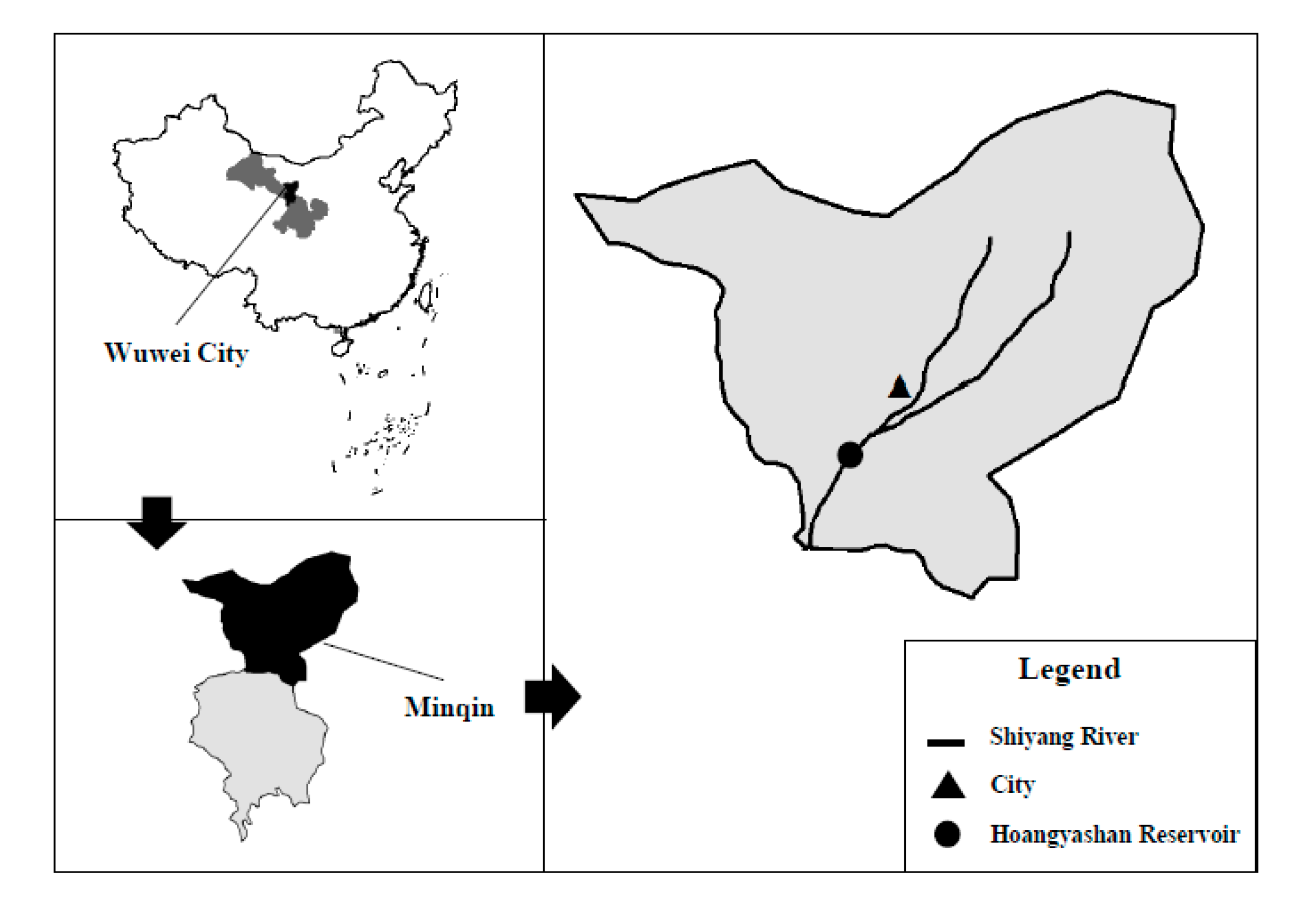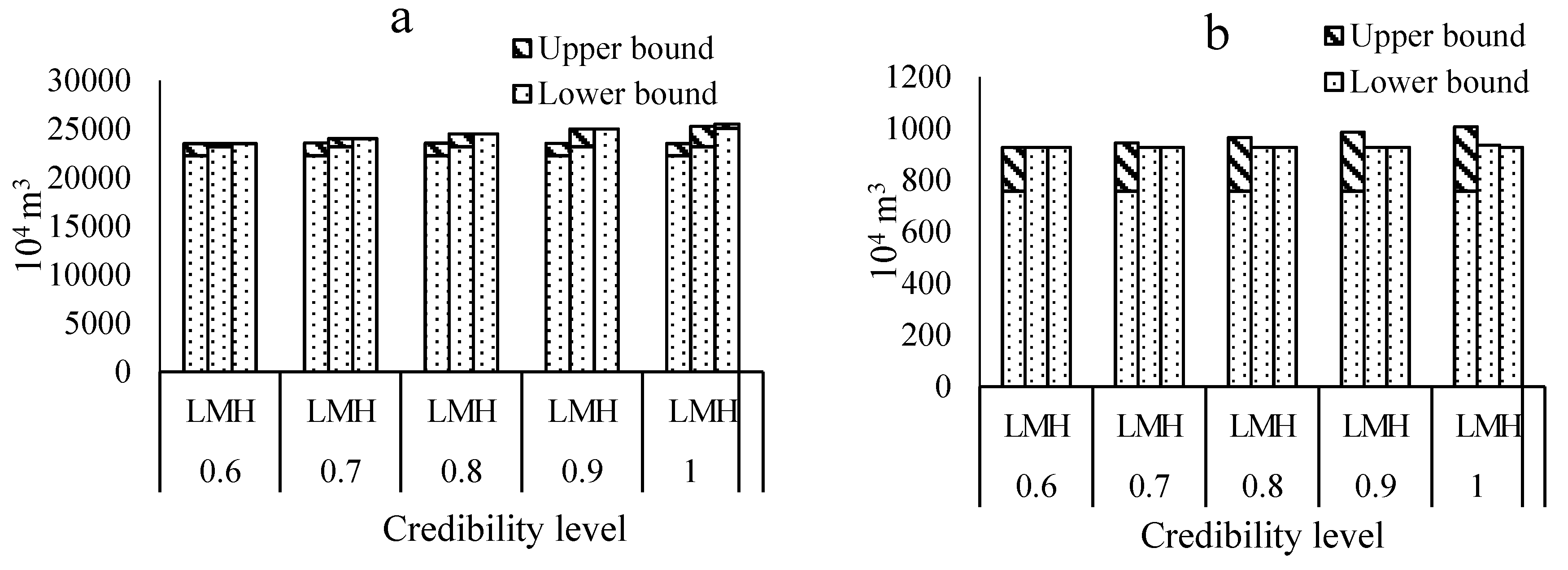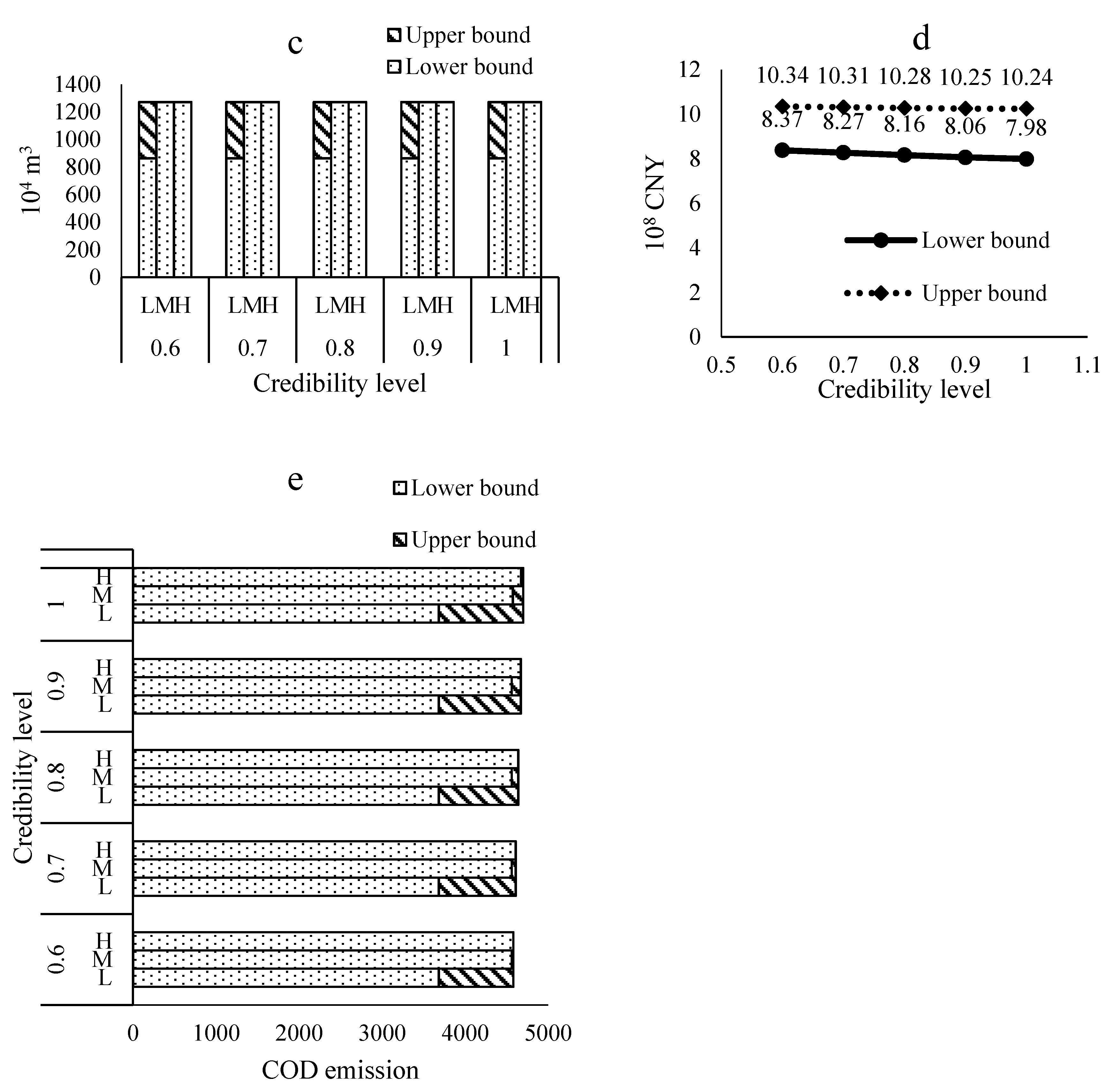A Regional Water Optimal Allocation Model Based on the Cobb-Douglas Production Function under Multiple Uncertainties
Abstract
:1. Introduction
2. Methodology
2.1. Cobb-Douglas Production Function (CD Function) for Water Demand Prediction
2.2. Fuzzy Credibility-Constrained Interval Two-Stage Stochastic Programming (FCITSP) for Regional Water Allocation
- (1)
- available water constraint
- (2)
- regional allowable chemical oxygen demand emission constraint
- (3)
- minimum water demand constraint
- (4)
- Non-negative constraint
3. Application
3.1. Study Area
3.2. Data Collection
4. Results and Discussion
4.1. Results of Water Demand Prediction
4.2. Water Resources Optimal Allocation Results
4.3. Discussions
5. Conclusions
Acknowledgments
Author Contributions
Conflicts of Interest
References
- Zhao, J.; Li, M.; Guo, P.; Zhang, C.; Tan, Q. Agricultural water productivity oriented water resources allocation based on the coordination of multiple factors. Water 2017, 9, 490. [Google Scholar] [CrossRef]
- Ji, L.; Sun, P.; Ma, Q.; Jiang, N.; Huang, G.; Xie, Y. Inexact Two-Stage stochastic programming for water resources allocation under considering demand uncertainties and response—A case study of Tianjin, China. Water 2017, 9, 414. [Google Scholar] [CrossRef]
- Xiang, H.X.; Xiao, F.X.; Lei, X. Study on improved PCA-SVM model for water demand prediction. Adv. Mater. Res. 2012, 591–593, 1320–1324. [Google Scholar]
- Zeng, X.T.; Li, Y.P.; Huang, W.; Chen, X.; Bao, A.M. Two-stage credibility-constrained programming with Hurwicz criterion (TCP-CH) for planning water resources management. Eng. Appl. Artif. Intell. 2014, 35, 164–175. [Google Scholar] [CrossRef]
- Jain, A.; Varshney, A.K.; Joshi, U.C. Short-Term water demand forecast modelling at IIT kanpur using artificial neural networks. Water Resour. Manag. 2001, 15, 299–321. [Google Scholar] [CrossRef]
- House-Peters, L.A.; Chang, H. Urban water demand modeling: Review of concepts, methods, and organizing principles. Water Resour. Res. 2011, 47, 1837–1840. [Google Scholar] [CrossRef]
- Haque, M.M.; Rahman, A.; Hagare, D.; Kibria, G. Principal component regression analysis in water demand forecasting: An application to the Blue Mountains, NSW, Australia. Vet. Pathol. 2016, 45, 842–848. [Google Scholar]
- Gui, Z.; Li, M.; Guo, P. Simulation-Based inexact fuzzy Semi-Infinite programming method for agricultural cultivated area planning in the shiyang river basin. J. Irrig. Drain. Eng. 2016, 143. [Google Scholar] [CrossRef]
- Choudhury, B.U.; Sood, A.; Ray, S.S.; Sharma, P.K.; Panigrahy, S. Agricultural area diversification and crop water demand analysis: A remote sensing and GIS approach. J. Indian Soc. Remote 2013, 41, 71–82. [Google Scholar] [CrossRef]
- Ahmed, A.A.; Fogg, G.E.; Gameh, M.A. Water use at Luxor, Egypt: Consumption analysis and future demand forecasting. Environ. Earth Sci. 2014, 72, 1–13. [Google Scholar] [CrossRef]
- Zhu, L.Y.; Lei, X.Y.; Wen, J. Forecast analysis of Aksu city’s water demand based on quantitative quota method. J. Water Resour. Water Eng. 2012, 23, 16–18. (In Chinese) [Google Scholar]
- Zhang, Z.G.; Shao, Y.S.; Xu, Z.X. Prediction of urban water demand based on Engel Index and Hoffmann Coefficient. Shuili Xuebao 2010, 41, 1304–1309. (In Chinese) [Google Scholar]
- Jia, S.; Long, Q.; Wang, R.Y.; Yan, J.; Kang, D. On the inapplicability of the Cobb-Douglas production function for estimating the benefit of water use and the value of water resources. Water Resour. Manag. 2016, 30, 3645–3650. [Google Scholar] [CrossRef]
- Zhang, D.; Guo, P. Integrated agriculture water management optimization model for water saving potential analysis. Agric. Water Manag. 2016, 170, 5–19. [Google Scholar] [CrossRef]
- Zhang, Q.; Diao, Y.; Dong, J. Regional water demand prediction and analysis based on Cobb-Douglas model. Water Resour. Manag. 2013, 27, 3103–3113. [Google Scholar] [CrossRef]
- Huang, G.H.; Loucks, D.P. An inexact two-stage stochastic programming model for water resources management under uncertainty. Civ. Eng. Environ. Syst. 2000, 17, 95–118. [Google Scholar] [CrossRef]
- Li, Y.P.; Huang, G.H.; Nie, S.L.; Nie, X.H.; Maqsood, I. An interval-parameter two-stage stochastic integer programming model for environmental systems planning under uncertainty. Eng. Optim. 2006, 38, 461–483. [Google Scholar] [CrossRef]
- Guo, P.; Huang, G.H.; He, L.; Zhu, H. Interval-parameter two-stage stochastic semi-infinite programming: Application to water resources management under uncertainty. Water Resour. Manag. 2009, 23, 1001–1023. [Google Scholar] [CrossRef]
- Ren, C.F.; Li, R.H.; Zhang, L.D.; Guo, P. Multiobjective stochastic fractional goal programming model for water resources optimal allocation among industries. J. Water Resour. Plan. Manag. 2016, 142. [Google Scholar] [CrossRef]
- Zhang, F.; Guo, P.; Li, M. Planting structure optimization of main crops in the middle reaches of Heihe River basin based on dual interval two stage stochastic programming. J. China Agric. Univ. 2016, 21, 109–116. (In Chinese) [Google Scholar]
- Tan, Q.; Huang, G.H.; Cai, Y.P. Radial interval chance-constrained programming for agricultural non-point source water pollution control under uncertainty. Agric. Water Manag. 2011, 98, 1595–1606. [Google Scholar] [CrossRef]
- Wang, Y.Y.; Huang, G.H.; Wang, S.; Li, W. A stochastic programming with imprecise probabilities model for planning water resources systems under multiple uncertainties. Stoch. Environ. Res. Risk Assess. 2016, 30, 2169–2178. [Google Scholar] [CrossRef]
- Zeng, X.; Kang, S.; Li, F.; Zhang, L.; Guo, P. Fuzzy multi-objective linear programming applying to crop area planning. Agric. Water Manag. 2010, 98, 134–142. [Google Scholar] [CrossRef]
- Zhang, Y.; Hang, G. Fuzzy robust credibility-constrained programming for environmental management and planning. J. Air Waste Manag. 2010, 60, 711–721. [Google Scholar] [CrossRef]
- Li, X.M.; Lu, H.W.; Li, J.; Du, P.; Xu, M.; He, L. A modified fuzzy credibility constrained programming approach for agricultural water resources management—A case study in Urumqi, China. Agric. Water Manag. 2015, 156, 79–89. [Google Scholar] [CrossRef]
- Zhang, C.; Guo, P. A generalized fuzzy credibility-constrained linear fractional programming approach for optimal irrigation water allocation under uncertainty. J. Hydrol. 2017, 553, 735–749. [Google Scholar] [CrossRef]
- Lu, H.; Du, P.; Chen, Y.; He, L. A credibility-based chance-constrained optimization model for integrated agricultural and water resources management: A case study in South Central China. J. Hydrol. 2016, 537, 408–418. [Google Scholar] [CrossRef]
- Tan, Q.; Huang, G.H.; Cai, Y.P. Multi-Source multi-sector sustainable water supply under multiple uncertainties: An inexact Fuzzy-Stochastic quadratic programming approach. Water Resour. Manag. 2013, 27, 451–473. [Google Scholar] [CrossRef]
- Zhang, C.; Guo, P. An inexact CVaR two-stage mixed-integer linear programming approach for agricultural water management under uncertainty considering ecological water requirement. Ecol. Indic. 2017. [Google Scholar] [CrossRef]
- Cobb, C.W.; Douglas, P.H. A theory of production. Am. Econ. Rev. 1928, 18, 139–165. [Google Scholar]
- Aghion, P.; Howitt, P. A model of growth through creative destruction. Econometrica 1992, 60, 323–351. [Google Scholar] [CrossRef]
- Tinbergen, J. Professor douglas’ production function. Revue de Linstitut International de Statistique 1942, 10, 37–48. [Google Scholar] [CrossRef]
- Xie, S.L.; Zhong-Yi, K.E.; Ding, X.T. Prediction of water shortage quantity of china based on Cobb-Douglas production function. Water Sav. Irrig. 2014. [Google Scholar]
- Li, X.; He, L.; Lu, H. Research on plan model of water resources of uncertainty agriculture based on fuzzy and credibility constrained. J. Water Resour. Water Eng. 2014, 108–114. (In Chinese) [Google Scholar]
- Tan, Q.; Zhang, S.; Li, R. Optimal use of agricultural water and land resources through reconfiguring crop planting structure under socioeconomic and ecological objectives. Water 2017, 9, 488. [Google Scholar] [CrossRef]
- Ren, C.; Guo, P.; Yang, G.; Li, R.; Liu, L. Spatial and temporal analyses of water resources use efficiency based on data envelope analysis and malmquist index: Case study in Gansu province, China. J. Water Resour. Plan. Manag. 2016, 142, 4016066. [Google Scholar] [CrossRef]
- AQSIQ (General Administration of Quality Supervision, Inspection and Quarantine of the People’s Republic of China); SAC (Standardization Administration of the People’s Republic of China). Standard for Hydrological Information and Hydrological Forecasting; AQSIQ and SAC: Beijing, China, 2009. GB/T 22482-2008. (In Chinese) [Google Scholar]






| Parameters and Variables | Meanings and Descriptions |
|---|---|
| an interval with lower and upper bounds, “+” and “−” are the upper and lower bounds of the corresponding parameters, respectively. | |
| total cost (CNY). | |
| n | index of water sectors, n = 1,2,3, where n = 1 represents the primary industry (PI), n = 2 denotes the secondary industry (SI), n = 3 delegates the tertiary industry (TI). |
| m | different flow levels of available water, m = 1, 2, 3, where m = 1 denotes low flow level, m = 2 represents medium flow level, m = 3 means high flow level. |
| water use cost in sector i per m3 (CNY/m3). | |
| first-stage decision variable, which denotes the allocation target for water that is promised to sector n (m3). | |
| additional cost to sector n per m3 of water not delivered (CNY/m3). | |
| second-stage decision variable, which is the shortage of water to sector n when the flow is with probability (m3). | |
| allowable regional total chemical oxygen demand (COD) emission , which is a triangular fuzzy number. | |
| primary pollutant content per unit wastewater discharge of sector n. | |
| sewage discharge coefficient (SDC) of sector n. | |
| minimum water demand of sector n (m3), which can be simulated by CD function. | |
| credibility level (greater than 0.5). | |
| zn | coefficients between 0 and 1 transferred from the first stage decision variables. |
| optimal water allocation results of every industry. |
| Industry Type | SDC | COD Concentration (g/m3) | Water Distribution Target (104 m3) | Water Use Price (CNY/m3) | Excess Water Price (CNY/m3) |
|---|---|---|---|---|---|
| PI (n = 1) | 0.1 | 60 | [26,890, 29,900] | [2.5, 3.0] | [2.6, 3.1] |
| SI (n = 2) | 0.5 | 100 | [1066, 1380] | [3.2, 4.5] | [3.9, 4.8] |
| TI (n = 3) | 0.7 | 230 | [1290, 2139] | [2.9, 3.8] | [3.1, 4.2] |
| Flow Level | Available Water (108 m3) | Probability |
|---|---|---|
| Low flow level (L) (m = 1) | [2.39, 2.58] | 20% |
| Medium flow level (M) (m = 2) | [2.54, 2.75] | 60% |
| High flow level (H) (m = 3) | [2.73, 2.92] | 20% |
| Item | ln A(t) | α | β | R2 | QR |
|---|---|---|---|---|---|
| PI | 15.20954 | −0.122110 | −1.16840 | 0.92 | 90% |
| SI | 0.273011 | 0.389791 | 0.15251 | 0.95 | 100% |
| TI | 2.398414 | 0.416841 | −0.12044 | 0.90 | 100% |
| Item | 2016 | Optimization Results | |
|---|---|---|---|
| Water allocation schemes (104 m3) | PI | 24,890.00 | [23,202.87, 24,522.02] |
| SI | 658.00 | 926.94 | |
| TI | 1103.00 | 1270.19 | |
| Total water consumption (104 m3) | 26,651.00 | [25,400.00, 26,719.15] | |
| Total benefit (108 CNY) | 71.36 | [72.56, 74.11] | |
| Total cost (108 CNY) | [6.75, 8.18] | [6.47, 8.26] | |
| Benefit per unit water (CNY/m3) | 26.78 | [27.16, 29.18] | |
© 2017 by the authors. Licensee MDPI, Basel, Switzerland. This article is an open access article distributed under the terms and conditions of the Creative Commons Attribution (CC BY) license (http://creativecommons.org/licenses/by/4.0/).
Share and Cite
Zhang, F.; Tan, Q.; Zhang, C.; Guo, S.; Guo, P. A Regional Water Optimal Allocation Model Based on the Cobb-Douglas Production Function under Multiple Uncertainties. Water 2017, 9, 923. https://doi.org/10.3390/w9120923
Zhang F, Tan Q, Zhang C, Guo S, Guo P. A Regional Water Optimal Allocation Model Based on the Cobb-Douglas Production Function under Multiple Uncertainties. Water. 2017; 9(12):923. https://doi.org/10.3390/w9120923
Chicago/Turabian StyleZhang, Fan, Qian Tan, Chenglong Zhang, Shanshan Guo, and Ping Guo. 2017. "A Regional Water Optimal Allocation Model Based on the Cobb-Douglas Production Function under Multiple Uncertainties" Water 9, no. 12: 923. https://doi.org/10.3390/w9120923






